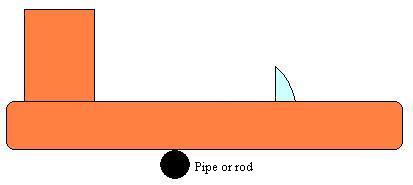
| NAME |
|
PARTNER'S NAME
When designing and building a hovercraft, weight is always a major concern. Increasing the weight of the hovercraft means the pressure inside the lift air cushion must be greater in order to keep the craft hovering. This means the lift fan must work harder to supply more air to the cushion. Additionally, a heavier hovercraft requires more thrust to move forward. Remember Newton’s second law:
Force = Mass • Acceleration
A more massive hovercraft will require more force to be accelerated. This results
in a greater workload on the engine.
No matter what the intended use for the hovercraft, decreasing its weight is
a benefit. A lighter racing hovercraft will be able to accelerate faster. If
the craft is used for transporting people and cargo, any hovercraft weight that
can be skimmed off can be added back in extra cargo weight space. For any hovercraft
decreasing the weight of the craft increases its fuel efficiency.
The finished weight of a DiscoverHover One:
| Average | 190 lbs | 86.18 kg |
| Good | 180 lbs | 81.65 kg |
| Excellent | 175 lbs | 79.38 kg |
You may be able to find a scale that can directly measure weights of this magnitude. If this is the case, measuring the weight of a hovercraft is quite simple, as shown in the diagram. Be sure to zero the scale before taking the measurement. To do this, hold the scale with only the lift straps hanging on it, then adjust it so that the scale reads zero. Once this is done, simply hang the hovercraft from the scale using the same straps and measure its weight.

This method will only work if you have a scale that can handle the weight of the hovercraft. If you only have a small scale, you can still measure the weight of your hovercraft. Doing so will require some sort of steel or wooden beam. Drill holes on either end of the beam so that the hovercraft can hang from one end, and the scale can be attached to the other end. Drill a third hole in the beam that is closer to the hovercraft than to the scale and place a large bolt through it. By hanging this bolt from the ceiling or supporting it from the ground, you can make a sort of see-saw out of the beam. Recall the see-saw example in the torque curriculum guide. We found that a lighter person can balance with a heavier person if the lighter person is sitting further away from the fulcrum, or pivot point. We can take advantage of this concept to measure the weight of the hovercraft.

Remember that torque is the weight or force multiplied by the
distance from the point of rotation. In order for the beam to balance, the torque
due to the weight of the hovercraft must be equal to the torque acting on the
scale. From the equations in the diagram you can now see that the weight of
the hovercraft will be equal to the ratio of the lengths times the weight measured
by the scale. This means that if the length from the bolt to the scale is ten
times longer than the length from the bolt to the hovercraft, then a 200 lb
hovercraft will be measured as 20 lb by the scale. This allows you to measure
the weight of a hovercraft using a scale that normally couldn’t handle
weights that large.
There are a few things to keep in mind when using this method. First, be sure
that the bolt is well lubricated so that the beam can pivot easily. Also be
sure that the beam is balancing flat when taking the measurement. The weight
of the beam must be considered since the pivot point isn’t in the middle
of the beam. Account for this by measuring the weight at the end of the beam
before the hovercraft is attached, as shown in the diagram. Be sure to keep
the lift sling attached to the beam.

Perhaps the scale measures a weight of 5 lb. This means that the
scale-end of the beam is trying to fall down with a force of 5 lb. When the
hovercraft is attached, the scale-end of the beam will be pulled up by the hovercraft,
so this 5 lb will be acting against the weight of the hovercraft. This means
you will have to add this weight onto the measured weight of the scale before
multiplying by the ratio of lengths. Additionally, be sure to zero the scale
before measuring both the beam and the hovercraft.
In addition to the hovercraft’s weight, another important property to
know is the hovercraft’s center of gravity.
This is the point about which the hovercraft will balance in every direction.
To find this, set the hovercraft on a pipe or rod running from side to side
of the hovercraft. Move it back and forth until the craft balances on the pipe
or rod and record this position. Now place the pipe or rod so that it is running
from front to back of the hovercraft and again find the position at which it
balances. The point where the two lines intersect is the center of gravity.
Knowing the location of the center of gravity is important because adding weight
anywhere except at that point will cause the craft’s weight balance to
change.
